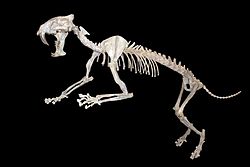Hoplophoneus
| Hoplophoneus Temporal range:
| |
|---|---|

| |
| Hoplophoneus skeleton | |
Fossil
| |
| Scientific classification | |
| Kingdom: | |
| Phylum: | |
| Class: | |
| Order: | |
| Family: | |
| Genus: | Hoplophoneus Cope, 1874
|
| Species | |
| |
Hoplophoneus is an extinct genus of the family Nimravidae, subfamily Nimravinae endemic to North America during the Late Eocene-Oligocene epochs (38—33.3 mya), existing for approximately 4.7 million years.[1]
Taxonomy

Hoplophoneus was named by Cope (1874). It was synonymized subjectively with Drepanodon by Palmer (1904) and Scott and Jepsen (1936). It was assigned to Hoplophoneinae by Flynn and Galiano (1982); to Nimravinae by Bryant (1991); and to Nimravidae by Cope (1874), Simpson (1941), Hough (1949) and Martin (1998).[2][3][4]
Morphology
Hoplophoneus was similar to cats in outward appearance, but the Nimravidae were not true cats. Bone structure was different in the small bones of the inner ear. True cats housed an external structure called an auditory bulla separated by a septum with two chambers. Nimravid remains showed no trace of this auditory bulla. Nimravidae had partially cartilaginous bulla and the presence of an ossified bulla with no septum. They also had a flange on the front of the mandible, not as prominent as those on Thylacosmilus, that projected downward as long as the canine tooth. Hoplophoneus was structured like the true cat Smilodon including the saber-like teeth but was about the size of a small leopard. It had a robust body with shorter legs.

The largest known specimen was examined by Sorkin (2008) for body mass and was estimated to have a weight of 160 kg (350 lb).[5]
Species
H. dakotensis, H. kurteni, H. mentalis (syn. H. oharrai), H. occidentalis (syn. Dinotomius atrox), H. primaevus (syn. H. insolens, H. latidens, H. marshi, H. molossus, H. robustus, Machaerodus oreodontis), H. sicarius
Sources
- ^ PaleoBiology Database: Hoplophoneus, basic info
- ^ W. B. Scott and G. L. Jepsen. 1936. Transactions of the American Philosophical Society
- ^ J. J. Flynn and H. Galiano. 1982. Phylogeny of early Tertiary Carnivora, with a description of a new species of Protictis from the middle Eocene of northwestern Wyoming. American Museum Novitates 2725:1-640
- ^ H. N. Bryant. 1991. Phylogenetic relationships and systematics of the Nimravidae (Carnivora). Journal of Mammalogy
- ^ Sorkin, B. 2008: A biomechanical constraint on body mass in terrestrial mammalian predators. Lethaia, Vol. 41, pp. 333–347
